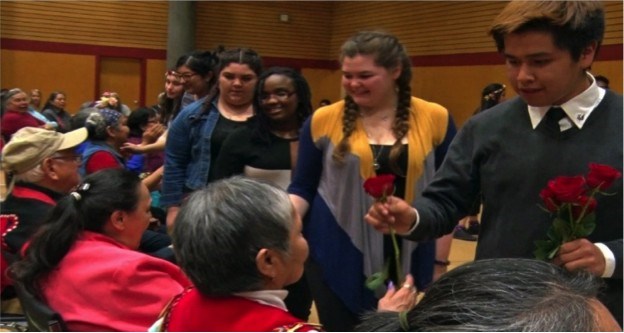Last month, B.C.'s education ministry released data that showed high-school completion rates were on the rise across the province — and some of the most promising figures can be found right here in the Sea to Sky.
Overall, graduation rates for B.C. residents in the district have climbed from 79.6 per cent in 2009-10, to 96.9 per cent in 2016-17 — a full 12 percentage points above the provincial average.
That positive trend is even more significant for Indigenous students. In 2009-10, the grad rate for Indigenous learners sat at just 39 per cent. Last year, that number topped 86 per cent, the highest Indigenous completion rate anywhere in the province.
So what can we attribute those skyrocketing rates to? According to School District 48 (SD48) Superintendent Lisa McCullough, it can be traced back to a groundbreaking partnership between the district and the Squamish Nation.
"When you look at a graph, you see the grad rates go up and the suspension rates plummet, and I really have to tell you, sincerely, that it is from embracing the Indigenous worldview of humanity and child development," she explained.
In October, the Nation and SD48 renewed a five-year protocol agreement that "will continue to drive forward one of the most successful collaborations for Aboriginal education in history," according to a district release. (A Squamish Nation official could not be reached by deadline.)
The agreement provides a structure for district and Nation officials to meet and discuss education in the corridor. This effort is being bolstered by a team of "shared learning teachers," provided by the Nation, who meet regularly to discuss ways to incorporate Indigenous elements into the curriculum and support classroom teachers in the process.
A key example of this is the district-wide adoption of the "Circle process," a practice common among many Indigenous cultures aimed at facilitating healthy dialogue.
"That's a wonderful way of giving choice, voice and opportunity to every student in the class and to support students connecting with each other and building stronger relationships," said Susan Leslie, SD48's principal of Indigenous education. "It empowers student engagement and keeps kids coming to school."
The district's commitment to Indigenous learning means students of all backgrounds have the chance to hear the Squamish language spoken in their classroom (or, in the case of schools in and around the Pemberton area, the Lil'wat Nation's language, Ucwalmícwts).
That effort has not been without its challenges, though, as few speakers of either language remain in the Squamish and Lil'wat communities. To that end, a handful of students are taking part in courses in the Lower Mainland with the goal of eventually teaching their language to other community members.
The Indigenous focus in recent years has been coupled with a broader emphasis on a bottom-up approach to education in the district.
"It means that we look at authentic learning experiences for students to support student engagement. Sometimes our most vulnerable learners aren't engaged because they can't connect to the classroom, to the place or the content being taught in the classroom," Leslie said. "If you design your learning with that focus, the experience and outcomes of all students improve, and we've proven that."
This "strength-based" approach, as Leslie called it, gives students the chance to centre their learning on what matters most to them, and stems from district officials' desire to facilitate an education model that was more "personal and human," McCullough explained.
"It's at the core of how we know we can support all of our learners — and it isn't just for Indigenous kids, it's for everybody."
For the 80 or so students in the district's Aboriginal Youth Council, the shift to a student-driven model has allowed them to raise awareness of important issues facing their communities. In December, members of the council met with B.C. Lieutenant Governor Judith Guichon to discuss the impacts of LNG on their land. The council also organizes the annual 24 Hour Drum, which last spring focused on the dark legacy of residential schools and how government policies have impacted their relatives over Canada's 150-year history.
"It's probably our most powerful group that's leading the district down a path of reconciliation," Leslie said.
The recent push in the district has also helped to instil a greater sense of belonging for many Indigenous students, who for the first time are seeing their culture and heritage reflected back at them in the classroom.
"I see them have a sense of identity that they can be proud of. I see them learning about a culture that is hard for even their parents to maintain. I see them taking leadership in their community... I see their confidence rising," McCullough said. "Now I have students tell me they are proud to be First Nation, they're proud to talk about it and share their identity openly in schools and in the community."




